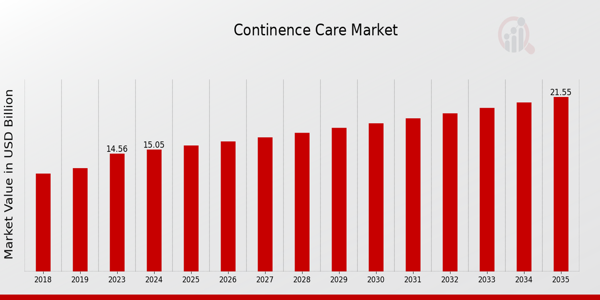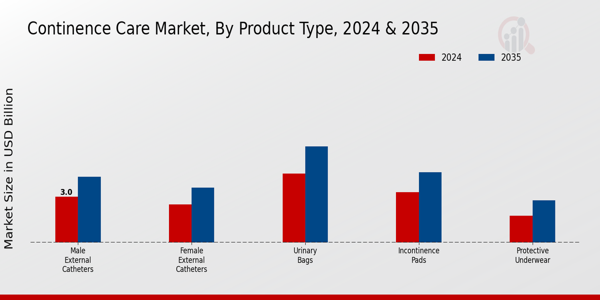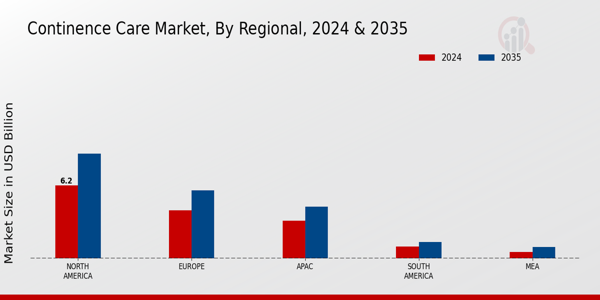Continence Care Market Overview
As per MRFR analysis, the Continence Care Market Size was estimated at 14.56 (USD Billion) in 2023. The Continence Care Market Industry is expected to grow from 15.05 (USD Billion) in 2024 to 21.56 (USD Billion) by 2035. The Continence Care Market CAGR (growth rate) is expected to be around 3.32% during the forecast period (2025 - 2035).
Key Continence Care Market Trends Highlighted
The Continence Care Market is driven by an increasing prevalence of urinary incontinence among various age groups, particularly in the elderly population. Rising awareness about continence products and the necessity for enhanced hygiene and comfort is also fueling market growth. Innovations in product design, such as improved absorbency and discreetness, are meeting consumer demands for convenience and effectiveness. Additionally, tailored solutions for both men and women are being developed to address specific needs, further contributing to market expansion. Opportunities lie in the growing emphasis on preventive healthcare and wellness.
This shift encourages the introduction of innovative products that not only provide management solutions but also promote a better quality of life. There is also potential for market expansion in emerging economies where healthcare access is improving. Stronger healthcare infrastructure can lead to increased distribution and acceptance of continence products. Digital health innovations, including mobile applications for product ordering and education, represent a new avenue to engage consumers and foster brand loyalty. In recent times, the trend towards sustainability and eco-friendly materials has been noticeable. Companies are beginning to focus on biodegradable and recyclable products in response to environmental concerns.
This aligns with consumer preferences for greener options, creating a niche market. Moreover, the rise of telehealth as a channel for consultations and education concerning continence management shows promise. Patients can now seek advice from healthcare professionals remotely, enhancing access to information and resources. As consumer expectations evolve, the continence care sector will likely continue to adapt, focusing on comfort, sustainability, and accessibility.

Source: Primary Research, Secondary Research, MRFR Database and Analyst Review
Continence Care Market Drivers
Growing Elderly Population
The Continence Care Market Industry is fueled by an elderly population. The world has a larger aging population, which exhibits a higher prevalence of incontinence. Many physiological changes that arise with old age lead to poor bladder and bowel control. As a result, there is a growing need for continence care, in particular adult diapers, pads and catheters.
Economic development and strengthening of healthcare infrastructure, coupled with a better understanding of the issue of incontinence, is driving this market forward. Furthermore, there is a strong focus on the comfort and usability of products as the life expectancy of elderly people continues to rise. Awareness surrounding effective care strategies is also increasing among healthcare providers, resulting in a wider availability of incontinence care products. Increased spending on healthcare among developing countries is benefiting the incontinence care market as well.
The stagnation in market growth, which previously resulted from a lack of focus on the specialized needs of older adults, is now a thing of the past. Increased investment in research and technology will innovate existing continence care products, enabling improved customer satisfaction. The market will thrive in the foreseeable future due to the growing demand for specialized care for elderly people.
Rising Awareness and Acceptance
There has been a marked increase in awareness regarding health issues, including incontinence, in recent years. Educational campaigns and initiatives are being launched to destigmatize incontinence, ultimately leading to higher acceptance among individuals facing these challenges. This shift creates a more open dialogue around continence care and encourages those who are affected to seek solutions. The Continence Care Market Industry benefits from these efforts as consumers become more willing to purchase products to manage their conditions effectively.
As awareness increases, it not only drives market demand but also fosters the development of new and improved products tailored to consumer needs.
Technological Advancements
Technological innovation plays a crucial role in the development of both new products and improvements to existing ones in the Continence Care Market Industry. With advances in materials, design, and manufacturing methods, companies are able to create products that are more comfortable, absorbent, and discreet. These innovations help in addressing consumer concerns, thus enhancing product performance and efficacy. By investing in research and development, manufacturers can lead the way in creating solutions that cater specifically to diverse consumer needs, further propelling market growth.
Continence Care Market Segment Insights:
Continence Care Market Product Type Insights
The Continence Care Market, categorized by Product Type, is witnessing significant growth, driven by increasing awareness of personal hygiene and rising incidences of urinary incontinence across various demographics. In 2024, products associated with this market are expected to render a substantial overall market valuation, contributing to the overall development of the industry. The market segmentation reveals key players within the category: Male External Catheters, Female External Catheters, Urinary Bags, Incontinence Pads, and Protective Underwear.
Male External Catheters hold a notable position, with a valuation of 3.0 USD Billion in 2024. This sub-segment is significant as it supports ease of use and comfort for male patients, ensuring a higher adoption rate in medical settings, especially among the aging population. Female External Catheters also play a critical role, projected at a valuation of 2.5 USD Billion during the same year. This category proves vital for enhancing comfort and dignity for women who are dealing with incontinence issues. The Urinary Bags segment dominates with a market value of 4.5 USD Billion in 2024, showcasing a majority holding compared to other products, mainly due to their wide usage in both hospitals and home care settings, significantly contributing to the overall Continence Care Market revenue.
Incontinence Pads and Protective Underwear each have a bearing on the market, with valuations of 3.3 USD Billion and 1.75 USD Billion, respectively, in 2024. Incontinence Pads are favored for their convenience and discretion, making them a significant player in daily care routines, while Protective Underwear is increasingly popular among consumers seeking comfort and discretion during day-to-day activities, leading to a gradual rise in its market presence. Overall, the Continence Care Market statistics unveil an industry characterized by strong demand across these product types, driven by a combination of increased awareness, product innovation, and enhancements in consumer convenience, ultimately presenting opportunities for further growth as the demographic challenges shift over time.

Source: Primary Research, Secondary Research, MRFR Database and Analyst Review
Continence Care Market Usage Insights
The Continence Care Market focuses on various usage segments, reflecting a diverse range of consumer preferences and needs in the industry. The market is projected to be valued at 15.05 USD Billion in 2024, demonstrating strong growth prospects. Within this segment, the distribution of products can be categorized into three main types: Disposable, Reusable, and Hybrid products. Disposable options are widely favored due to their convenience and low maintenance, leading to a substantial majority holding in the market. Reusable products, while less prevalent, appeal to environmentally conscious consumers and can offer cost-effectiveness over time.
Meanwhile, Hybrid products combine features of both disposable and reusable items, providing versatility and adaptability in usage scenarios, which enhances their significance among diverse user groups. Market trends are influenced by an aging population, increased awareness of continence issues, and innovations in product design, creating ample opportunities for growth. However, challenges such as product affordability and the need for effective marketing strategies persist. The continuous demand for enhanced comfort and discretion in continence care demonstrates the potential of the Continence Care Market revenue as it evolves through these usage preferences.
Continence Care Market Distribution Channel Insights
The Distribution Channel segment of the Continence Care Market plays a vital role in ensuring the accessibility and availability of continence care products. By 2024, this market is expected to be valued at 15.05 billion USD, showcasing significant growth potential. Within this segment, various channels operate, including Hospital Pharmacies, Retail Pharmacies, Online Stores, and Medical Supply Stores, each contributing uniquely to market dynamics. Hospital Pharmacies are essential for providing patients with immediate needs, whereas Retail Pharmacies serve a broader audience by making products easily accessible to consumers.
Online Stores have gained considerable traction due to the convenience they offer, allowing consumers to purchase products discreetly, which is a significant factor driving growth in this channel. Meanwhile, Medical Supply Stores cater to specialized needs, playing a crucial role in serving individuals requiring chronic care solutions. The increasing awareness of continence care solutions and the growing aging population contribute to the overall market growth, presenting opportunities for enhancement and expansion across all distribution channels.
Market trends indicate a shift towards digitalization, with online platforms expected to experience substantial growth as customers seek seamless purchasing experiences.
Continence Care Market End User Insights
The Continence Care Market revenue has been seeing steady growth with the market expected to reach a valuation of 15.05 USD Billion in 2024. The End User segment plays a crucial role in this market, encompassing various settings such as hospitals, nursing homes, and home care environments. Hospitals remain a significant contributor, as they cater to a vast range of medical needs and offer advanced continence care products. Nursing homes also hold a major share, driven by the increasing elderly population requiring specialized care for urinary and fecal incontinence.
Home care settings have emerged as an important segment, increasingly favored for their convenience and personalized care approaches. The interplay among these sectors highlights prevalent market trends driven by an aging demographic, rising awareness regarding incontinence, and advancements in care products and technologies. However, challenges such as reimbursement policies and the need for comprehensive training for caregivers persist. Overall, the Continence Care Market segmentation reflects a diversifying landscape that is attuned to the evolving preferences of patients and healthcare providers.
With significant growth potential, this market is poised to meet the rising demands for effective continence care solutions.
Continence Care Market Regional Insights
The Continence Care Market showcases significant regional variations, with North America leading in market revenue, valued at 6.2 USD Billion in 2024 and projected to reach 8.9 USD Billion by 2035, reflecting its majority holding in the industry. Europe follows closely, holding a substantial value of 4.1 USD Billion in 2024, expected to rise to 5.8 USD Billion by 2035, emphasizing its importance in the Continence Care Market. The Asia-Pacific (APAC) region, although smaller in comparison, is emerging with a valuation of 3.2 USD Billion in 2024 and anticipated growth to 4.4 USD Billion by 2035, indicating a significant opportunity for expansion due to increasing healthcare access.
South America holds a modest position with a valuation of 1.0 USD Billion in 2024, projected to grow to 1.4 USD Billion by 2035, reflecting rising awareness of continence products. The Middle East and Africa (MEA) region, with a value of 0.55 USD Billion in 2024, is anticipated to reach 0.96 USD Billion by 2035, marking it as the least dominant segment yet highlighting potential growth avenues as awareness increases. Overall, the Continence Care Market segmentation illustrates diverse opportunities and challenges across regions, driven by variations in healthcare infrastructure, demographic trends, and economic factors.

Source: Primary Research, Secondary Research, MRFR Database and Analyst Review
Continence Care Market Key Players and Competitive Insights:
The Continence Care Market has become increasingly competitive due to the rising awareness of urinary and fecal incontinence, particularly among the aging population and individuals with certain medical conditions. Various companies are striving to capture market share by innovating their products, enhancing distribution channels, and improving customer service. This competitive landscape comprises established multinational firms as well as emerging players that are focusing on specific market segments. In an effort to cater to the diverse needs of consumers, businesses are investing in research and development to introduce advanced, efficient, and user-friendly continence care products. The landscape is characterized by a mix of strategic partnerships, mergers and acquisitions, and marketing campaigns aimed at positioning brands more favorably in the eyes of consumers.
Procter and Gamble has positioned itself strongly within the Continence Care Market by leveraging its extensive experience in consumer goods and its robust research capabilities. The company has successfully introduced a range of products that prioritize customer comfort, absorption efficiency, and overall quality. Its significant investment in branding and marketing ensures widespread recognition, making its continence care products a go-to choice for many consumers. Procter and Gamble capitalize on its presence, allowing for consistent product availability while also adapting to the specific needs of diverse markets. This adaptability is a key strength as it enables the company to stay ahead of competitors and respond effectively to changing consumer preferences, ensuring a loyal customer base. Furthermore, the company's commitment to sustainability and innovation keeps it relevant in a market that increasingly values eco-friendly and technologically-enhanced solutions.
B. Braun Melsungen holds a significant position in the Continence Care Market, underpinned by its focus on healthcare and medical devices. The company stands out due to its comprehensive and high-quality product offerings, which range from catheters to absorbent products aimed at improving patient care and comfort. B. Braun Melsungen is recognized for its commitment to research and development, which drives innovation and positions its products as reliable options for consumers dealing with continence issues. The company also emphasizes the importance of healthcare professional support, providing extensive training and resources to ensure effective product usage. This not only enhances customer satisfaction but also helps in building trust and credibility in both hospital and home care settings. With a strong emphasis on clinical excellence and patient-focused solutions, B. Braun Melsungen continues to strengthen its market presence and differentiate itself from competitors in the continence care sector.
Key Companies in the Continence Care Market Include:
- Procter and Gamble
- Braun Melsungen
- Attends Healthcare
- Drylock Technologies
- Hollister
- Ontex
- Dahlhausen
- KimberlyClark
- Coloplast
- Unicharm
- SCA Personal Care
- First Quality Enterprises
- Essity
- Medtronic
- Cardinal Health
Continence Care Market Industry Developments
The Continence Care Market is experiencing notable developments, with several major players making strides. Procter and Gamble and Kimberly-Clark continue to enhance their product lines, focusing on innovation in disposable absorbent products. B. Braun Melsungen and Coloplast have been active in expanding their market presence, emphasizing the importance of research and development to improve product efficacy and user experience. Drylock Technologies and Attends Healthcare recently launched eco-friendly options, catering to a growing demand for sustainable hygiene solutions.
Additionally, the market has seen some mergers and acquisitions, with companies such as Medtronic and Cardinal Health exploring partnerships to broaden their distribution channels and enhance service delivery. The rise in awareness regarding incontinence issues among different demographics has led to an increased market valuation for companies involved, driving enhanced investments and marketing efforts. As a result, the market is projected to grow significantly, influenced by the ongoing advancements in technology and growing consumer demand for high-quality continence care products.
Continence Care Market Segmentation Insights
Continence Care Market Product Type Outlook
- Male External Catheters
- Female External Catheters
- Urinary Bags
- Incontinence Pads
- Protective Underwear
Continence Care Market Usage Outlook
Continence Care Market Distribution Channel Outlook
- Hospital Pharmacies
- Retail Pharmacies
- Online Stores
- Medical Supply Stores
Continence Care Market End User Outlook
- Hospitals
- Nursing Homes
- Home Care Settings
Continence Care Market Regional Outlook
- North America
- Europe
- South America
- Asia Pacific
- Middle East and Africa
| Attribute/Metric Source: |
Details |
| MARKET SIZE 2023 |
14.56 (USD Billion) |
| MARKET SIZE 2024 |
15.05 (USD Billion) |
| MARKET SIZE 2035 |
21.56 (USD Billion) |
| COMPOUND ANNUAL GROWTH RATE (CAGR) |
3.32% (2025 - 2035) |
| REPORT COVERAGE |
Revenue Forecast, Competitive Landscape, Growth Factors, and Trends |
| BASE YEAR |
2024 |
| MARKET FORECAST PERIOD |
2025 - 2035 |
| HISTORICAL DATA |
2019 - 2024 |
| MARKET FORECAST UNITS |
USD Billion |
| KEY COMPANIES PROFILED |
Procter and Gamble, B. Braun Melsungen, Attends Healthcare, Drylock Technologies, Hollister, Ontex, Dahlhausen, KimberlyClark, Coloplast, Unicharm, SCA Personal Care, First Quality Enterprises, Essity, Medtronic, Cardinal Health |
| SEGMENTS COVERED |
Product Type, Usage, Distribution Channel, End User, Regional |
| KEY MARKET OPPORTUNITIES |
Aging population demand, Innovative product development, Growing awareness campaigns, Telehealth integration, Personalized continence solutions |
| KEY MARKET DYNAMICS |
Aging population growth, Increasing demand for products, Rising awareness and education, Advancements in technology, Expanding healthcare expenditure |
| COUNTRIES COVERED |
North America, Europe, APAC, South America, MEA |
Frequently Asked Questions (FAQ) :
The Global Continence Care Market is expected to be valued at 15.05 USD Billion in 2024.
By 2035, the market is projected to reach a value of 21.56 USD Billion.
The expected CAGR for the Global Continence Care Market from 2025 to 2035 is 3.32%.
North America is expected to hold the largest market share valued at 6.2 USD Billion in 2024.
The market value for Protective Underwear is expected to reach 2.76 USD Billion by 2035.
Male External Catheters are expected to be valued at 3.0 USD Billion in 2024 and 4.3 USD Billion in 2035.
Major players in the market include Procter and Gamble, B. Braun Melsungen, and Kimberly Clark among others.
The market for Urinary Bags is expected to grow to 6.3 USD Billion by 2035.
The MEA region is projected to be valued at 0.96 USD Billion by 2035.
In 2024, Incontinence Pads are expected to be valued at 3.3 USD Billion.
















